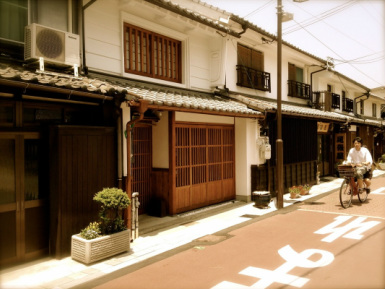|
From 1000 metres above Earth my neighborhood looks like an overcrowded circuit board; a dense cluster of houses spanning a century in design, dissected by a winding river called the Semba, and at the centre, a long narrow street on which sits a 100-year-old house made of bamboo, mud and clay tiles. My home for the past 14 years.
I could describe this project as ‘peeling back the layers of the onion’ or like ‘dipping a jar into a river to capture all the weird and wonderful organisms that co-exist in it’—but I won’t. I’ll simply tell my neighborhood like it is, each week with a new perspective. Naming it would be ‘localising’ too much, so let’s just call it the Good Hood--an average neighborhood in a city called Himeji (pop. 550,000), located 50km west of Kobe in western Honshu. Like any other in Japan, it has a Shinto shrine, Buddhist temple, barber shop, hair salon, highschool, 7-Eleven, yakitori restaurant, post office, liquor shop, summer and autumn festivals and a traditional shopping street lined with turn-of-the-century town houses, or machiya. And through it all wends a small river whose depth and flow reflect the seasonal moods of western Honshu. Time has gathered the old communities into towns and cities, even turned some into metropolises, but the cho, or neighborhood, remains the heart and soul of Japan. Roll back my sliding door, step out onto a jute door mat (favoured by the local stray) and I stand on a street strung with an impossible number of power and telephone lines. To the north lies the Shinto shrine with its ancient wood pavilion guarded by dragons and fearsome stone lion-dogs. To the south, where the paddies have been smothered by new homes, young housewives gather to chew over their boring lives and await their kids return from school. Long after dark, the buses will disgorge their tired ‘salarymen’ husbands who drift heavy-hearted back to their homes and sleeping families. Japan’s population is 127 million and falling; my neighborhood (23 houses) is about 127 people and also falling. As the population ages and old family houses are abandoned and left to their own devices, they attract new inhabitants: birds, insects, reptiles, runaway pets and other exotic animalia. But let me tell you about that some other time. It’s this ‘devolving’ of my neighborhood that motivates me to tell you about its sights, sounds, smells, quirky rituals and personal charm before they disappear altogether! Next week: Sounds of the Good Hood.
1 Comment
|
This Blog:What is the essence of a traditional Japanese neighbourhood? Writing from my home in Himeji, a castle town in western Honshu, Seaweed Salad Days distills, ferments, presents! Archives
March 2024
Categories
All
|

 RSS Feed
RSS Feed
